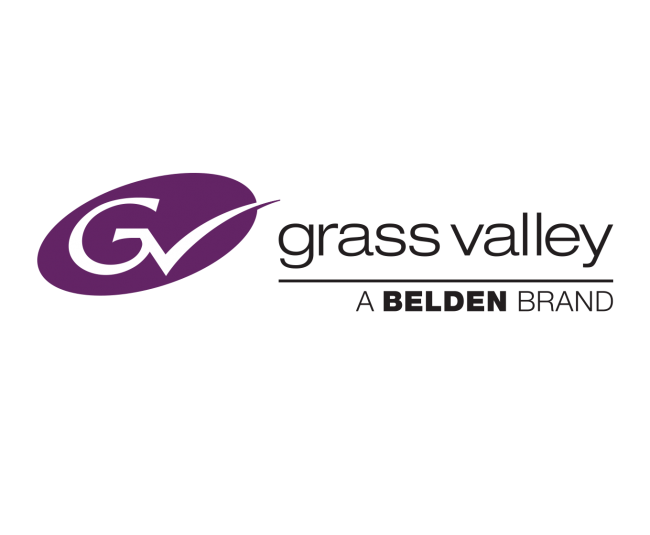NAB 2017: Grass Valley Highlights HDR, Live IP Production
New solutions exhibited by Grass Valley, a Belden Brand, at NAB 2017 were focused on HDR and IP workflow. Compatible with new and existing LDX cameras, the new Densité UHD-3901-UC cards are designed to handle both native HDR and SDR content for a seamless look. The new XCU Universe UXF base station supports the AIMS roadmap and all IP video formats. Support for Dell’s Isilon All-Flash storage platform is now available for Grass Valley’s iTX contend-delivery platform.
 Densité UHD-3901-UC Cards
Densité UHD-3901-UC Cards
To support a mixture of HDR and SDR content, Grass Valley has integrated HDR up-mapping capabilities into the new Densité UHD-3901-UC cards. The cards can accommodate a gradual adoption of HD production elements into UHD broadcasting workflows, while protecting investment in installed equipment with a model for both SDR to HDR and HD to 4K UHD upconversion.
As broadcast studios upgrade to 4K UHD, the new upconversion module allows existing, installed equipment to be used and integrated into more advanced workflows. This includes the up-mapping of SDR content to live within the increasingly popular HDR workflow.
The new LDX 82 Series cameras, all existing LDX 86 Series and LDX 86N Series cameras, the Densité UHD-3901-UC cards, K2 Summit media servers, and other Grass Valley solutions are designed to handle both native HDR and SDR content for a seamless look.
“HDR started as an artistic nice-to-have but is becoming a necessity to create the depth of color and contrast that live content viewers crave,” says Neerav Shah, SVP, strategic marketing, Grass Valley. “Grass Valley’s unique ability to capture native HDR or convert SDR on the fly makes it easy for broadcasters to implement an HDR workflow that delivers content in great color and quality to dramatically enhance the viewing experience. Our customers can easily incorporate high-value HDR content into their mix because of our end-to-end support.”
No matter what camera, production switcher, replay system, server or network component, Grass Valley offers full support in all of its products for a native HDR workflow that allows customers to produce more engaging content and capture more revenue.
“The ability to mix HDR content with SDR content and graphics created by legacy solutions is critical to broadcasters looking to create high-quality content for their viewers,” says Shah. “Broadcasters need solutions that make the conversion and up-mapping process simple and seamless, and Grass Valley has provided just that while continuing to develop technology to integrate multi-format content even more smoothly.”
XCU Universe UXF
Grass Valley is offering the next step toward full IP live production with the XCU Universe UXF camera base station and advanced UXF cradle. Together, these solutions support the AIMS roadmap and all IP video formats, including high-speed operation and HDR, providing the flexibility for current workflows, for burgeoning IP workflows, and beyond.
“We have a number of customers who are already embracing the benefits of IP-based networks to improve performance and efficiency,” says Shah. “The new XCU Universe UXF supports the high-bandwidth needs of increasingly prevalent 4K video and IP networks while also delivering maximum production flexibility with hybrid SDI/IP features.”
The XCU Universe UXF base stations are designed to support the extended bandwidth requirements of the LDX 86 and LDX 86N Series high-speed cameras with up to 6X-speed operation, 4K capability, and 15 F-stops of HDR in 1X speed operation. XCU now provides enormous overall flexibility with the ability to output any format of video over IP (including TR-03, TR-04, and the new proposed standard ST 2110) or SDI. The new, advanced UXF cradle also features additional 4X MSA-compliant SFP+ slots, adding fully redundant IP interfacing and 12G SDI through SFP.
As additional support for productions shared over high-bandwidth IP networks, the XF Transmission Direct IP Interface eLicense enables a direct IP interface of the complete transmission protocol between the cameras and XCUs over IP networks.
Storage for Playout, News Production
Over the years, Grass Valley has relied on Dell EMC Isilon storage solutions for many of its products for such applications as playout and news production.
“Broadcast operations are essentially mission critical, with each piece of equipment playing a key role in ensuring the smooth production and delivery of content,” says Boromy Ung, VP, news, Grass Valley. “We have worked closely with Dell EMC over the years to qualify interoperability of our products with their Isilon storage solutions, and that work continues today with some of the exciting new products that are available.”
The Grass Valley iTX Integrated Playout Platform advanced content-delivery solution is used by broadcast brands worldwide, delivering more than 20 million hours of media in the past year. Many of our customers employ a Dell EMC Isilon storage solution as the primary store for valuable broadcast media. The new Isilon All-Flash storage platform offers significant bandwidth and IOPS performance, which complements Grass Valley’s iTX On-Demand solution, enabling broadcasters and content owners to deliver tailored VOD content to multiple platforms in advance of playout for prerecorded shows or to reduce turnaround time of a live event from hours to just minutes after it finishes airing. iTX is the first content-delivery platform to support Isilon All-Flash.
“For broadcasters, speed and reliability are basic requirements in storage,” says Tom Burns, CTO, media and entertainment, Dell EMC. “The flash technology employed in Isilon All-Flash offers new levels of performance that are particularly well-suited to the demands of content creation and broadcast media.”
For news production, the GV STRATUS video-production and content-management system is now qualified for the Dell EMC Isilon X410 storage system, which means that users have peace of mind when choosing this combination for their operations, no matter the size or budget.
